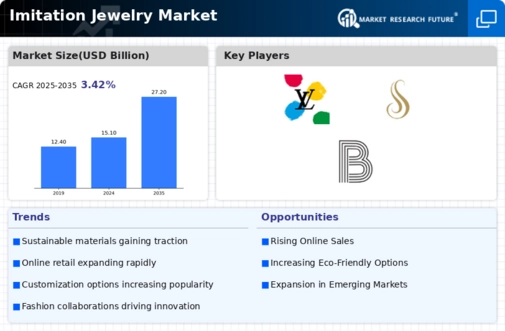Top Industry Leaders in the Imitation Jewelry Market

The imitation jewelry market has emerged as a dynamic sector within the fashion industry, providing consumers with affordable and trendy accessories. As of 2023, key players in this market have strategically positioned themselves to cater to the growing demand for fashionable yet cost-effective jewelry. The competitive landscape is shaped by factors such as design innovation, pricing strategies, and the ability to adapt to changing fashion trends.
Key Players:
LOUIS VUITTON (France)
Stuller, Inc. (US)
Yurman Design, Inc. (US)
Billig Jewelers, Inc. (US)
DCK Concessions (UK)
Avon Product Inc. (US)
BaubleBar Inc. (US)
Buckley Jewellery Limited (UK)
Gianni Versace S.p.A. (Italy)
Strategies Adopted:
The imitation jewelry market employ various strategies to maintain and enhance their market positions. Rapid product turnover is a common approach, with brands continuously introducing new designs to align with the latest fashion trends. Pricing strategies, including offering budget-friendly options and periodic discounts, are essential to appeal to a broad consumer base. Effective supply chain management allows companies to respond swiftly to emerging trends and restock popular items. Moreover, collaborations with influencers and celebrities contribute to brand visibility and resonance with specific consumer segments. The utilization of e-commerce platforms and digital marketing is crucial for reaching a wider audience and capitalizing on the growing trend of online shopping.
Market Share Analysis:
The imitation jewelry industry involves evaluating several factors. Brand recognition and consumer trust are significant contributors, influencing purchasing decisions in a market where perceived quality and style are key drivers. The ability to offer a wide variety of designs, including replicas of high-end jewelry, enhances market share by appealing to diverse consumer preferences. Distribution efficiency, both through brick-and-mortar stores and e-commerce channels, is crucial for reaching a broad customer base. Pricing competitiveness and the incorporation of sustainable practices, reflecting changing consumer values, are additional factors that impact market share dynamics.
News & Emerging Companies:
The imitation jewelry market has seen the emergence of new players focusing on niche segments, unique designs, and sustainable practices. Emerging companies often leverage digital marketing and e-commerce to establish their presence in a competitive market. News in this industry typically revolves around collaborations with influencers, innovative design approaches, and efforts to enhance sustainability by using eco-friendly materials. The emergence of smaller, direct-to-consumer brands emphasizes the importance of agility and niche targeting in the imitation jewelry sector.
Industry Trends:
The imitation jewelry market often highlights trends in materials, design, and sustainability. Companies are increasingly investing in eco-friendly practices, incorporating recycled materials, and adopting ethical sourcing in response to consumer demand for more sustainable fashion options. Investment trends also reveal a focus on technology, with companies incorporating augmented reality (AR) and virtual try-on features in their online platforms to enhance the digital shopping experience. Moreover, there is a growing emphasis on transparency in the supply chain, with companies investing in traceability technologies to communicate the sourcing and manufacturing processes to consumers.
Competitive Scenario:
The imitation jewelry market is marked by a mix of fast fashion giants, specialty retailers, and emerging direct-to-consumer brands. Established players leverage their global presence and supply chain capabilities to provide a vast array of affordable and stylish options. Fast fashion brands, in particular, capitalize on their ability to quickly adapt to fashion trends, offering a constant stream of new designs at competitive prices. Emerging brands focus on differentiation through unique designs, sustainable practices, and direct engagement with consumers through online platforms.
The rise of e-commerce has reshaped the competitive landscape, with brands vying for attention in the digital space. Effective digital marketing, responsive customer service, and seamless online shopping experiences are crucial for success. Additionally, brands that strike a balance between offering budget-friendly options and aligning with sustainable practices are better positioned to resonate with the values of the modern consumer.
Recent Development
H&M continued its efforts in digital innovation by launching an augmented reality (AR) feature on its mobile app, allowing customers to virtually try on imitation jewelry before making a purchase. This development showcased H&M's commitment to enhancing the online shopping experience and leveraging technology to bridge the gap between online and in-store interactions. Claire's Stores, Inc. embraced inclusivity by expanding its range of imitation jewelry to cater to diverse skin tones and style preferences. The brand's commitment to offering jewelry suitable for a wide range of consumers emphasized the importance of representation and diversity in the fashion industry.
Zara, in response to changing consumer behaviors, invested in enhancing its e-commerce platform with personalized recommendations and an improved










